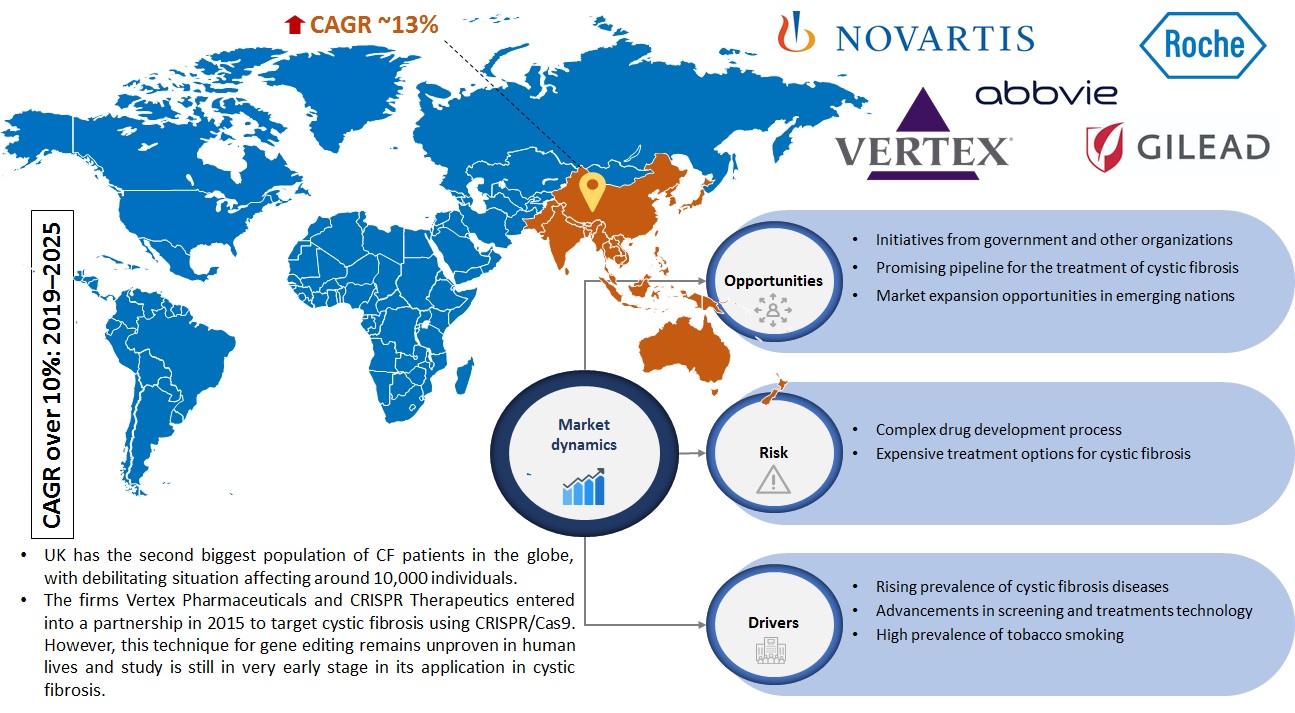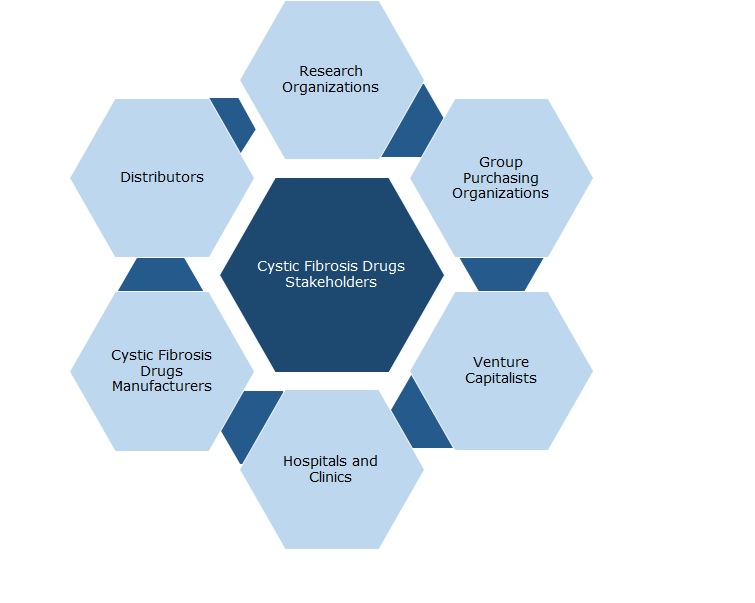
Cystic Fibrosis Drugs Market By Drug Class (CFTR Modulators, Mucolytics, Bronchodilators, Pancreatic Enzyme Supplements, and Others), By Route of Application (Oral, Inhalation and Intravenous), By Region (North America, Europe, Asia Pacific, and Rest of the World) – Global Forecast up to 2025
- August, 2019
- Domain: Healthcare - Pharmaceuticals
- Get Free 10% Customization in this Report
This market research report includes a detailed segmentation of the global cystic fibrosis drugs market by drug class (CFTR Modulators, Mucolytics, Bronchodilators, Pancreatic Enzyme Supplements, and Others), by route of application (Oral, Inhalation, and Intravenous), by region (North America, Europe, Asia Pacific, and Rest of the World).
Overview of the Global Cystic Fibrosis Drugs Market
Infoholic’s market research report predicts that the “Global Cystic Fibrosis Drugs Market” will grow at a CAGR of more than 10% during the forecast period 2019–2025. The market has witnessed steady growth in the past few years and is sustaining due to rising prevalence of cystic fibrosis diseases, advancements in screening and treatments technology, and high prevalence of tobacco smoking.

Initiatives from government and other organizations, promising pipeline for the treatment of cystic fibrosis, and market expansion opportunities in emerging nations are providing scope for the growth of the cystic fibrosis drugs market. However, complex drug development process and expensive treatment options is restraining the growth of cystic fibrosis market.
The majority of the revenue is generated from the leading players in the market with dominating sales from AbbVie, F. Hoffmann-La Roche, Gilead Sciences, Vertex Pharmaceuticals, Novartis, Advanced Inhalation Therapies (AIT) Ltd., Alcresta Therapeutics Inc., Allergan, AstraZeneca, Merck & Co. Inc., and Teva Pharmaceutical Industries.
According to market analysis, North America accounted for the largest share of the global cystic fibrosis drugs market in 2018. The Asia Pacific region is expected to increase due to large patient pool and more prevalence of respiratory diseases in this region.
By Drug Class:
- CFTR Modulators
- Mucolytics
- Bronchodilators
- Pancreatic Enzyme Supplements
- Others
Recent information published by Proteostasis in March 2019 for its proprietary triple combination drug PTI-NC-733 (PTI-428/PTI-801/PTI-808) expressed concerns as to whether Proteostasis would contest Vertex\'s grip on the CFTR modulator place.
By Route of Administration:
- Oral
- Inhalation
- Intravenous
Among the various route of administrations, oral administration holds the majority share in the cystic fibrosis market in 2018.
By Regions:
- North America
- Europe
- APAC
- RoW
North America dominates the global cystic fibrosis drugs market in 2018 closely followed by Europe. Ireland has the most cystic fibrosis prevalence worldwide – around 1 out of 19 individuals in Ireland carry one copy of a mutated gene that can cause cystic fibrosis.
Cystic Fibrosis Drugs Market Research Competitive Analysis – Current cystic fibrosis medications are not appropriate for all patients and has restricted impact on this life-threatening disease. But these hurdles can be overcome by new developments of various therapeutic approaches. The development of small molecules for the treatment of cystic fibrosis has made important advancement in the previous decade. However, one of the major issues is that the success in the treatment options has been observed in only certain mutation classes among the 2000 mutations identified. Thus, many patients do not have any treatment.
Key Vendors:
- AbbVie
- Hoffmann-La Roche
- Gilead Science, Inc.
- Vertex Pharmaceuticals
- Novartis
Key Competitive Facts
- The firms Vertex Pharmaceuticals and CRISPR Therapeutics entered into a partnership in 2015 to target cystic fibrosis using CRISPR/Cas9. However, this technique for gene editing remains unproven in human lives and study is still in very early stage in its application in cystic fibrosis.
- Restoration of CFTR function, mucociliary clearance, anti-inflammation, and anti-infective agents are the therapeutic approaches that are used in the development of effective drugs for CF.
Benefits – The report provides complete details about the sub-segments of the cystic fibrosis drugs market. Through this report, the key stakeholders can know about the major trends, drivers, investments, vertical player’s initiatives, and government initiatives toward the disease management in the upcoming years along with details of the existing pure-play companies and new players entering the market. Moreover, the report provides details about the major challenges that are going to impact the market growth. Additionally, the report gives complete details about the key business opportunities to key stakeholders in order to expand their business and capture the revenue in specific verticals and to analyze before investing or expanding the business in this market.
Key Takeaways:
- Understanding the potential market opportunity with precise market size and forecast data.
- A detailed market analysis focusing on the growth of the cystic fibrosis drugs
- Factors influencing the growth of the cystic fibrosis drugs
- In-depth competitive analysis of dominant and pure-play vendors.
- Prediction analysis of the cystic fibrosis drugs market in both developed and developing regions.
- Key insights related to major segments of the cystic fibrosis drugs
- Latest market trend analysis impacting the buying behavior of the consumers
Key Stakeholders

1 Industry Outlook
1.1 Industry Overview
1.2 Total Addressable Market
2 Report Outline
2.1 Report Scope
2.2 Report Summary
2.3 Research Methodology
2.4 Report Assumptions
3 Market Snapshot
3.1 Market Definition – Infoholic Research
3.2 Segmented Addressable Market (SAM)
3.3 Industry Trends
3.4 Related Markets
3.4.1 Respiratory Pipeline
4 Market Outlook
4.1 Product Pipeline
4.2 Market Segmentation
4.3 Porter 5 (Five) Forces
5 Market Characteristics
5.1 Market Dynamics
5.1.1 Drivers
5.1.1.1 Rising prevalence of cystic fibrosis diseases
5.1.1.2 Advancements in screening and treatments technology
5.1.1.3 High prevalence of tobacco smoking
5.1.2 Restraints
5.1.2.1 Complex drug development process
5.1.2.2 Expensive treatment options for cystic fibrosis
5.1.3 Opportunities
5.1.3.1 Initiatives from government and other organization
5.1.3.2 Promising pipeline for the treatment of cystic fibrosis
5.1.3.3 Market expansion opportunities in emerging nations
5.1.4 DRO – Impact Analysis
5.2 Key Stakeholders
6 Drug Class: Market Size and Analysis
6.1 Overview
6.2 CFTR Modulators
6.3 Mucolytics
6.4 Bronchodialators
6.5 Pancreatic Enzyme Supplements
6.6 Others
7 Route of Administration: Market Size and Analysis
7.1 Overview
7.2 Oral
7.3 Inhalation
8 Regions: Market Size and Analysis
8.1 Overview
8.2 North America
8.2.1 Overview
8.3 Europe
8.3.1 Overview
8.4 Asia Pacific
8.4.1 Overview
8.5 Rest of the World
8.5.1 Overview
9 Competitive Landscape
10 Vendors Profile
10.1 AbbVie
10.2 F. Hoffmann-La Roche
10.3 Gilead Sciences, Inc.
10.4 Vertex Pharmaceuticals
10.5 Novartis
11 Companies to Watch for
11.1 Advanced Inhalation Therapies (AIT) Ltd.
11.2 Alcresta Therapeutics, Inc.
11.3 Allergan Plc
11.4 AstraZeneca
11.5 Merck & Co. Inc
11.6 PharmaSwiss
Research Framework
Infoholic research works on a holistic 360° approach in order to deliver high quality, validated and reliable information in our market reports. The Market estimation and forecasting involves following steps:
- Data Collation (Primary & Secondary)
- In-house Estimation (Based on proprietary data bases and Models)
- Market Triangulation
- Forecasting

Market related information is congregated from both primary and secondary sources.
Primary sources
involved participants from all global stakeholders such as Solution providers, service providers, Industry associations, thought leaders etc. across levels such as CXOs, VPs and managers. Plus, our in-house industry experts having decades of industry experience contribute their consulting and advisory services.
Secondary sources
include public sources such as regulatory frameworks, government IT spending, government demographic indicators, industry association statistics, and company publications along with paid sources such as Factiva, OneSource, Bloomberg among others.
